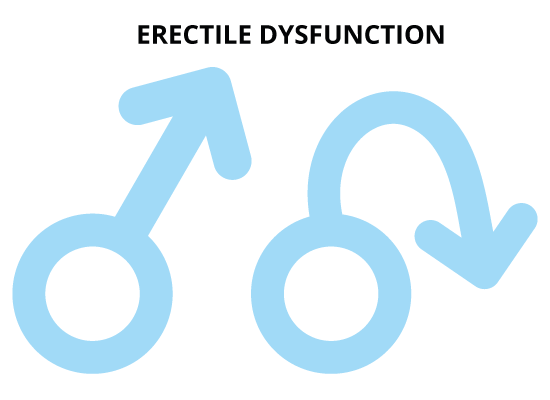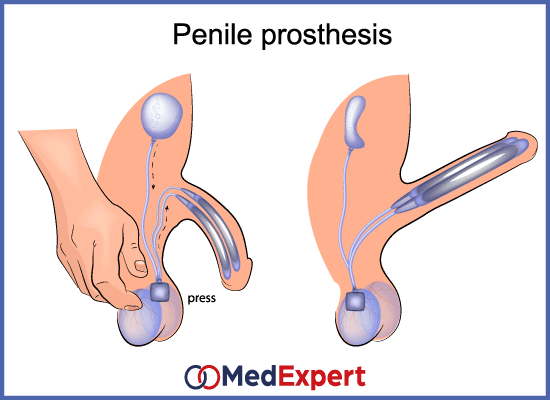ERECTILE DYSFUNCTION (ED)
One of the most common disorders in men is erectile dysfunction. ED symptoms include troubles obtaining and maintaining erection during intercourse. Erectile dysfunction treatment, same as with many other disorders depends on its primary cause. Nowadays there is a wide range of methods to treat erectile dysfunction. We are going to discuss them below, as well as the nature, causes and symptoms of this condition.
Erectile dysfunction can be described as not being able to maintain or get a proper erection. ED can occur in different cases, like, getting a partial erection but not hard enough for proper sex, lack of fullness and swelling of the penis. Erectile dysfunction is sometimes called impotence. The narrowing of the arteries whose function is to transport blood to the penis is the cause of most erectile dysfunctional cases. This cause is due to the build-up of fatty deposits (atheroma), the same way heart arteries are affected in those with heart disease. Erectile dysfunction is commonly treated by the use of a tablet before sexual intercourse.

HOW COMMON IS ERECTILE DYSFUNCTION?
There are various situations where men do not get an erection some of which include areas of stress, tiredness, distraction or getting inebriated with alcohol. In most men ED is temporary and they do get a proper erection when fully aroused. However, in some cases, there are men who have persistent ED and this tends to become a common occurrence as they increase in age. About half of men between the ages of 40 and 70 have ED. About 7 in 10 men aged 70 and above have ED.
ED SYMPTOMS
Symptoms of erectile dysfunction may include:
- Trouble getting an erection
- Trouble keeping an erection
- Reduced sexual desire
ERECTILE DYSFUNCTION TREATMENT OPTIONS
In the treatment of an erectile dysfunction there are various available treatment options depending on the cause and the severity of the problem. In choosing a method of treatment the risks and benefits of the available treatment options can be explained by the doctor. The preference of one’s partner can also factor in a treatment choice. There are various treatment options for erectile dysfunction and they largely depend on the cause and severity. Some treatments include:
- Medications: Erectile dysfunction can be successfully cured with medications. First-line treatment of erectile dysfunction would be oral medications known as phosphodiesterase-5 (PDE-5) inhibitors, which improve blood flow to the penis.
- Vacuum pump device: It draws blood into the penis by creating a negative pressure around the penile shaft. Once the penis becomes erect, a compression ring is applied at the base of the penis to prevent blood from draining out and must be removed after sexual intercourse is completed.
Penile Implants

As a last resort, patients may consider surgery to insert a prosthetic penile implant device in the penile shaft, which creates an erection by fluid flowing into the device from a concealed reservoir placed beneath the skin. Advantages of such penile implants include the consistency of good erections achieved and control of the duration of the erection.
Low-intensity shockwave therapy (LIST) to the penis has been found to be an effective treatment for patients with erectile dysfunction that are not responsive to oral medications. In this treatment, focused shockwaves of low intensity are targeted at the smooth muscle in the penis, causing mechanical shear stress and micro trauma. This causes the body to produce chemicals to improve blood flow and stimulate new vessel formation (angiogenesis) to the cavernosal tissue in the penile shaft.
Current treatment protocols comprise six sessions lasting 15 – 20 minutes each, over a three-week period, where shockwaves are administered to the penis. Whilst several patients report an improvement in erectile function, the response may wane over time and repeat treatment may be required.
DIAGNOSING ERECTILE DYSFUNCTION
- Physical Exam: This exam involves careful examination of the penis and testicles and also the checking of nerves for sensation.
- Blood Tests: Tests for signs of heart disease, diabetes, low testosterone levels and other health conditions are carried out on blood samples taken to the lab.
- Urine Tests: This test is similar to that of blood test which is carried out to test for signs of diabetes and other health conditions.
- Ultrasound: This test is carried out by a specialist in the office; it involves the use of a wand-like device (transducer) held over the blood vessels that supply the penis. A video image is produced to allow the doctor study the blood flow of the vessels to deduce if there are any problems. This test is sometimes done in combination with an injection of medications into the penis to stimulate blood flow and produce an erection.
- Overnight Erection Test: This test involves the use of wrapping a special device around one’s penis before going to bed; the device measures the number and strength of erections that are achieved overnight. This is because most men display erections during sleep without remembering them. This test can help determine if the erectile dysfunction is psychologically related.
- Psychological Exam: Questions are asked to test for depression and other possible psychological causes of erectile dysfunction.


